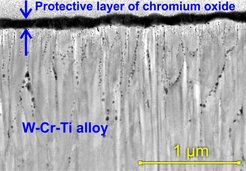Self-passivating tungsten alloys
To optimise the safety properties of a future power plant IPP is developing tungsten alloys which safeguard themselves against oxidation when they come into contact with oxygen.

Electron-microscopic cross-sectional image of a tungsten alloy after oxidation at 900 °C: The protective chromium oxide layer appears in the upper part of the image as a dark belt.
Figure: IPP
